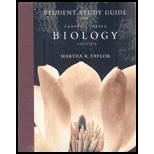
To label: The three components of an ATP molecule.
Introduction: Nucleotides belong to the class of organic compounds. They are the building blocks of DNA and RNA. Each
d.
To indicate: The bond in the ATP molecule that is likely to break.
Introduction: ATP is chemically known as adenosine triphosphate. It is a usable form of energy for cells.
To determine: The chemical mechanism that breaks the bond among ATP.
Introduction: ATP is a usable form of energy for cells. This energy is trapped in a
e.
To explain: The reason why the hydrolysis reaction of ATP releases so much energy.
Introduction: Hydrolysis reaction occurs when a biological macromolecule is broken down. The water molecules split when a complex macromolecule is broken.
Want to see the full answer?
Check out a sample textbook solution
Chapter 8 Solutions
Biology - Study Guide
- Which of the following letters on the figure contains the most energetic bond in ATP? A D B Carrow_forwardWhich of the following statements are true?For each, explain why or why not.(a) All coenzymes are electron-transfer agents.(b) Coenzymes do not contain phosphorus or sulfur.(c) Generating ATP is a way of storing energy.arrow_forwardWhich of the following statements concerning enzymes is TRUE? a. Enzymes can increase the equilibrium constant of a reaction by 1000-fold. b. The activity of many enzymes can be regulated. c. Many enzymes are consumed in the reactions they catalyze. d. The rate of enzymatic catalysis is independent of pH.arrow_forward
- Label the following statements true or false: (c) A nonspontaneous reaction will proceed spontaneously in the reverse direction. (d) A spontaneous process can occur with a large decrease in entropy.arrow_forwardWhich of the following statement regarding enzymes is false? a.) they speed up reaction rates b.) they work within narrow temperature and pH ranges c.) The active site binds the substarate d.) They are consumed in the reactions they catalyzearrow_forwardWhich of the following is not true about enzymes? a. They are consumed by the reactions they catalyze. b. They are usually made of amino acids. c. They lower the activation energy of chemical reactions. d. Each one is specific to the particular substrate(s) to which it binds.arrow_forward
- Energy is stored long-term in the bonds of _____ and used short-term to perform work from a(n)_____molecule. a. ATP : glucose b. an anabolic molecule : catabolic molecule c. glucose: ATP d. a catabolic molecule : anabolic moleculearrow_forwardPREDICT In the following reaction series, which enzyme(s) is/are most likely to have an allosteric site to which the end product E binds? (a) enzyme 1 (b) enzyme 2 (c) enzyme 3 (d) enzyme 4 (e) enzymes 3 and 4arrow_forwardFigure 4.15 Cyanide inhibits cytochrome c oxidase, a component of the electron transport chain. If cyanide poisoning occurs, would you expect the pH of the intermembrane space to increase or decrease? What affect would cyanide have on ATP synthesis? Figure 4.15 (a) The electron transport chain is a set of molecules that supports a series of oxidation-reduction reactions. (b) ATP synthase is a complex, molecular machine that uses an H+ gradient to regenerate ATP from ADP. (c) Chemiosmosis relies on the potential energy provided by the H+ gradient across the membrane.arrow_forward
- Which of the following is not true about enzymes?a. They are consumed by the reactions they catalyze.b. They are usually made of amino acids.c. They lower the activation energy of chemical reactions.d. Each one is specific to the particular substrate(s) to which it binds.arrow_forwardThe energy released by the hydrolysis of ATP is____ a. primarily stored between the alpha and beta phosphates b. equal to −57 kcal/mol c. harnessed as heat energy by the cell to perform work d. providing energy to coupled reactionsarrow_forwardExplain which of the following substances ATP, CoA-SH, FAD and NAD+ have the subunits in their structure? D.Have four different types of subunits.arrow_forward
 Biology (MindTap Course List)BiologyISBN:9781337392938Author:Eldra Solomon, Charles Martin, Diana W. Martin, Linda R. BergPublisher:Cengage Learning
Biology (MindTap Course List)BiologyISBN:9781337392938Author:Eldra Solomon, Charles Martin, Diana W. Martin, Linda R. BergPublisher:Cengage Learning Concepts of BiologyBiologyISBN:9781938168116Author:Samantha Fowler, Rebecca Roush, James WisePublisher:OpenStax College
Concepts of BiologyBiologyISBN:9781938168116Author:Samantha Fowler, Rebecca Roush, James WisePublisher:OpenStax College

